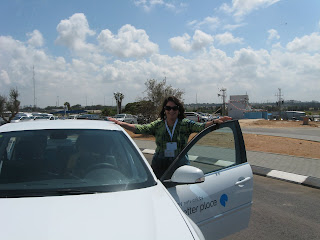

We spent our last day in Israel visiting in Afula - our Partnership 2000 sister city. Our morning began with a visit to the seam line checkpoint between Afula and the West Bank. Afula's close proximity to the town of Jenin made the area a hot bed of terrorism in the second intifada. 75% of the terrorists who engaged in suicide missions in Israel came from Jenin. Today the situation is completely different. Because of the cooperative efforts between the mayors of Afula/Gilboa and Jenin a spirit of cooperation and coexistence has emerged with the understanding that economic growth in the West Bank and Israel benefits all people. As of two months ago, Israeli Arabs are now allowed to travel back and forth through the checkpoint by car rather than just walking through on foot. This has allowed the economy in Jenin to grow by 40%. We were brought to the roof of the checkpoint and we were briefed by the man who manages the facility. It was incredibly enlightening to learn about the great success that has arisen from this area that was plagued by terrorism and mistrust. As we observed the view from the roof of this very successful checkpoint, it was hard not to be impressed by the peaceful and cooperative atmosphere in the area. We all wished that this was the story that made the news about Israel.
From that visit we traveled to a sifriyat pyjama (PJ Library) kindergarten classroom in Afula. We learned about how the program runs in Israel and we observed a lesson being taught. It was a lovely visit where we also learned about the demographics and challenges of the region. The books from this program are a real gift to the families who receive them and can not afford to buy their own home libraries.
After lunch a program supported by the Southern New England Consortium Partners (SNEC) was our next stop. This was a program run through the Jewish Agency's Youth Futures program. We visited children who live in very difficult home conditions and were not able to be successful in school. The youth futures program provides a holistic approach to children and families to give them they support needed to be successful in school and eventually in life. The children participate in classes that offer counseling, teach self esteem and life skills, communication skills, art therapy, music and much more. A team approach is taken between social workers, teachers and physicians to ensure that each child's needs are met fully. The program utilizes small groups with mentors so that all children receive one on one attention. We were all impressed with this model and felt that our inner cities in the United States could learn some lessons from this program. Proudly, our community supports this effort to make these childrens' lives better every day.
Our next visit was with middle school students who participate in a project through the Ethiopian National Project (ENP). This program takes the best and brightest students who come from disadvantaged homes and gives them the tools to be successful. The vast majority of the children who participate are new immigrant families from Ethiopia and the Former Soviet Union. Through the Anna P. Housen Israel Desk, we fund this program and ensure a bright future for teens who have difficult life circumstances and have significant challenges that other teens in Israel do not face. Without this funding, the program would not be able to operate.
Afula is an area where 40% of the community is made up of new immigrant families and they all face very difficult circumstances on many levels. The work that we are doing now will help make another generation of immigrants prosper in our homeland.
We enjoyed dinner with host families and then trekked back to Tel Aviv for the night. We were exhausted and happy, overwhelmed and inspired, confused and motivated. This was a wonderful trip and I was honored to spend time with such terrific community members. I hope that others will consider joining a Federation Mission the next time we offer one. There is no better way to learn about the intricacies, feel the history, see the sites, taste the food, admire the people, touch the land, and just be in Israel.
A very big big thank you to our mission chairs, Barbara and Jim Sadowsky who through their vision made this trip a reality.















































